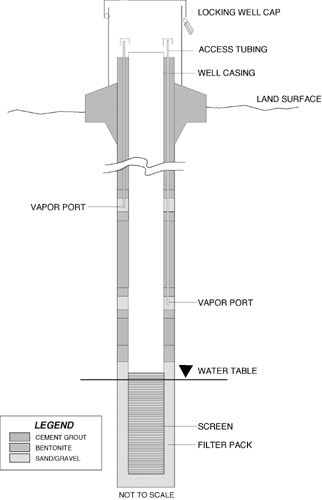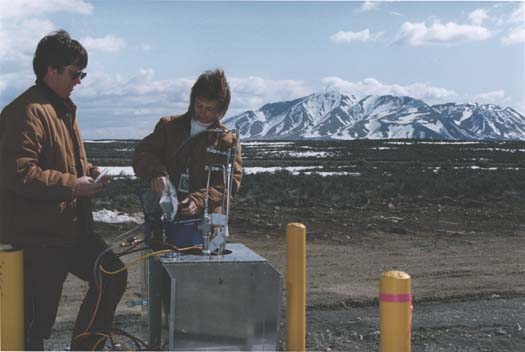|
October 1998 “Inside-Out” Well for Simultaneous Soil Vapor and Ground Water Samplingby Joel Hubbell, Idaho National Engineering and Environmental Laboratory Researchers at the U.S. Department of Energy’s Idaho National Engineering and Environmental Laboratory (INEEL) have developed a combination well for simultaneous gas and ground water sampling through the same borehole. Design of the “inside-out” well, in which gas sampling tubing and ports are attached on the exterior of the well casing, provides a means for simpler and less expensive sampling than conventional techniques. This technology was demonstrated initially at INEEL, and currently is used to monitor volatile organic compounds at various U.S. locations in the West and Southwest, including the Sandia National Laboratory, Los Alamos National Laboratory, and the Tucson Airport. Conventional designs for combined ground water and gas sampling wells place the gas sampling tubing inside the well casing, and sampling ports penetrate the casing at various depths. This approach physically interferes with the placement of ground-water pumps and samplers lowered within the well, and usually requires an inner casing. In the inside-out well, ground water and soil gas sampling activities do not interfere with each other, so the well can be used simultaneously for monitoring and remediation purposes, allowing direct comparison of data. The well is assembled easily in the field before the casing is placed in the borehole. Precise gas port depths are known, which reduces the potential for grouting over the ports after the casing is set. Demonstration of the combination well at INEEL’s Radioactive Waste Management Complex in Idaho involved the use of 7 wells constructed to depths up to 243 meters within a thick vadose zone (approximately 180 meters) consisting of basalt with fracture and cinder zones, and sedimentary interbeds. Each well contained 3-9 gas sampling ports, installed at depths ranging from 7.2-178 meters, to track chlorinated solvent vapors. Figure 1 provides a schematic diagram of the combination sampling well. The cost savings for these wells were estimated at $30,000 per well when compared to drilling separate wells.
This technology reduces the cost of long-term projects in which vapor sampling has been found to be more effective than soil matrix sampling for VOCs. For example, 6 vapor extraction wells at depths of 43-148 meters are used to monitor vapor extractions at a 2-acre chemical waste landfill at Sandia National Laboratory. Compared to an alternate system requiring 6 separate boreholes for soil gas monitoring, the combination wells saved approximately $60,000. Users of the combination well also have found that the combination well is effective in angled boreholes to reach areas of interest without drilling through the waste site itself.
For more information, contact Joel Hubbell (INEEL) at 208-526-1747 or E-mail jmh@INEL.gov. Honeybees and Bluegills Used for Environmental Monitoringby Jerry Bromenshenk, Ph.D., University of Montana, and Henry Gardner, DrPH, U.S. Army Center for Environmental Health Research Honey bees, electronic hives, and chemical analyses are used to help assess hazards posed by environmental contaminants and to signal their presence at Aberdeen Proving Ground, MD. This approach is used in parallel with a biomonitoring system using bluegills (Lepomis macrochirus) to monitor the quality of treated ground water. Continuous monitoring of honeybees and fish is well suited to address the terrestrial and aquatic effects of human activity. These continuous biological monitors provide an early warning of changing environmental conditions and a signal for appropriate action to be taken. From the late 1930s to 1953, the U.S. Army used Aberdeen Proving Ground’s Old O-Field as a dumping ground for chemical warfare agents, unexploded ordnance, munitions, and wastes from research and production facilities. This practice led to numerous contamination problems. To correct these problems, the Army recently installed a permeable cover of sand and gravel to cover the landfill and a ground-water treatment facility to capture and treat the contaminated ground water. The cover contains a subsurface trickling system for application of liquids or nutrients to enhance degradation, and a subsurface air-monitoring system to collect air samples, as needed. Bees were used to supplement standard chemical monitoring during installation of the cover by identifying possible chemical releases, and continue to be used during remediation efforts. Electronic beehives with infrared counters track bee flight activity at Old O-Field. These counters and other electronic features, such as air samplers and hive condition sensors, gather and transmit information to a central processing system capable of detecting anomalies in bee behavior. This behavior has been found to be closely associated with exposure to toxic contaminants. For example, changes in bee behavior were identified during installation of the landfill cover at the Old O-Field in 1996. Flight activity was low, queen bees disappeared, and hive temperatures fluctuated. Analysis showed that the abnormal behaviors coincided with very high levels of perchloroethylene (PCE) in the hives lacking queens. PCE contamination in the landfill had been identified earlier, but these behavioral differences signaled that PCE was bioavailable and enhanced hazard evaluation. In addition to flight patterns, honeybees can provide environmental information through a variety of methods. As collectors of plant nectar, pollen, and resins, as well as water, honeybees serve as environmental samplers to detect contaminant concentrations at levels as low as 100 parts per quadrillion. Researchers are able to measure contaminant bioavailability directly by analyzing whole bees or pollen collected from the hives, and can use “beehive headspace analysis” to identify volatile organic contaminants. In parallel with honeybee assessments, bluegills are monitored to assess acute aquatic hazards during remediation activities at Aberdeen Proving Ground. A biomonitoring system containing up to 32 bluegills in small, individual tanks is used to assist in evaluating the effectiveness of ground water treatment. The system tracks various patterns of fish activity to detect any effluent conditions from the treatment plant that may require a corrective action. At O-Field, each fish is connected to computer sensors and monitored continuously. Data are summarized at 15-minute intervals for ventilatory rate, ventilatory depth, cough (gill purge) rate, and whole body movement. As a side stream of treated ground water flows through the fish tanks, any significant changes in these variables are compared to each animal’s historical baseline response. The bluegill biomonitoring system is designed to identify acute toxicity in the water as indicated by the fish’s response. If six of eight fish show signs of stress, the system warns operators and a water sample is taken automatically. If necessary, a chemical analysis is performed; if a problem with the treated water is confirmed, the treatment plant will discontinue operations until the problem is corrected. This work is sponsored by Aberdeen Proving Ground’s Installation Restoration Program and the U.S. Army Center for Environmental Health Research (USACEHR), a detachment of the Army Research Institute of Environmental Medicine as part of the Army Medical Research and Materiel Command. For more information on honeybee monitoring, contact Dr. Jerry Bromenshenk (University of Montana) at 406-243-5648 or E-mail JJBmail@selway.umt.edu, or visit the Web site www.umt.edu/biology/bees. Contact Tommy R. Shedd (USACEHR) at 301-619-7576 or E-mail Tommy_R_Shedd@ftdetrck-ccmail.army.mil for additional information on the bluegill monitoring.
Remote Sensing Tools for Phytoremediation Site Assessmentby Suzette R. Burckhard, Ph.D., South Dakota State University Remote sensing is used increasingly to assess agricultural conditions at phytoremediation sites. At the Anaconda Company Smelter Site in Montana, South Dakota State University (SDSU) researchers are evaluating the correlations between remotely sensed data and field measurements. This information will be used to develop a large-scale model for predicting contaminant transport as affected by vegetation. Studies indicate that satellite or aerial photography data could reduce analytical costs by as much as 80% over conventional field methods, and allow for statistical averaging of data from large and/or remote field areas. The Anaconda Company Smelter Superfund site has a large number of contaminated soil areas as a result of past mining and smelting operations. Revegetation of 25 square miles of mine tailing piles, divided into 10 subplots, was initiated in 1992 to reduce surface erosion and limit the spread of contamination. Remotely sensed data and sources used for the Anaconda site include:
Integration of data from these sources is used to evaluate plant health and biomass growth, and to develop a normalized vegetation difference index. Results will be used to simulate potential scenarios at the Anaconda site regarding intermediate treatment of mine tailings. This model will be fully transferrable for designing monitoring schemes at other sites. Collection of remotely sensed data and correlation studies with existing field data continue while long-term monitoring of revegetation is conducted at the Anaconda site. Technical advisory assistance is provided by the Great Plains/Rocky Mountains Hazardous Substance Research Center, Northern Great Plains Water Resources Research Center, South Dakota Space Grant Consortium, and EDC. For more information, contact Dr. Suzette Burckhard (South Dakota State University) at 605-688-5316 or E-mail BurckhaS@ur.sdstate.edu. Field Sampling and Analysis Technology Resources AvailableThe Field Sampling and Analysis Matrix and Reference Guide is a quick reference source providing users a general understanding of the applicability of field analytical and innovative sampling technologies. The matrix and reference guide compare technologies along a number of application and performance parameters, including analytes, media, throughput, cost, data quality, investigation-derived wastes, state of development, precision, and accuracy. Users may view the matrix (in poster form) (EPA-542-B-98-002A) and reference guide (EPA-542-B-98-002) from the Federal Remediation Technologies Roundtable Web site http://www.frtr.gov, or obtain a free hard copy from the National Center for Environmental Publications and Information at 800-490-9198 or 513-489-8190.
EPA’s Technology Innovation Office has compiled a report, Field Analytical and Site Characterization Technologies: Summary of Applications, to document experiences in the use of chemical, geophysical, radionuclide, and sampling technologies for 204 contaminated site applications. Reported information for each technology includes the types of pollutants and media, advantages and limitations, and cost data. To obtain a free copy of the summary (EPA-542-R-97-011), download the document from the Clean-Up Information Web site http://clu-in.org, or contact the National Center for Environmental Publications and Information at 800-490-9198 or 513-489-8190. Case Study on Innovative Technologies and Strategies at Hanscom Air Force BaseEPA’s Technology Innovation Office (TIO) recently completed the first in a series of case studies designed to provide cost and performance information on innovative tools that support less costly and more representative site characterization. The first case study focuses on a number of innovative technologies and a dynamic, adaptive approach to streamline the overall site investigation process at Hanscom Air Force Base, MA. New technology applications and novel applications of conventional tools and processes are documented in the project report, Case Study: Hanscom Air Force Base Operable Unit 1 (EPA-542-R-98-006), which is available on TIO’s CLU-IN Web site at http://clu-in.org/char1.htm. This report summarizes more detailed project information available on CLU-IN.
TIO also is preparing a guide to assist in the collection and organization of project information into a concisely written case study. The interim guide will be available on CLU-IN this Fall. Public and private industry partners interested in contributing information on site-specific cases studies are invited to contact Deana Crumbling (EPA/TIO) at 703-603-0643.
|
|||
|
|||










